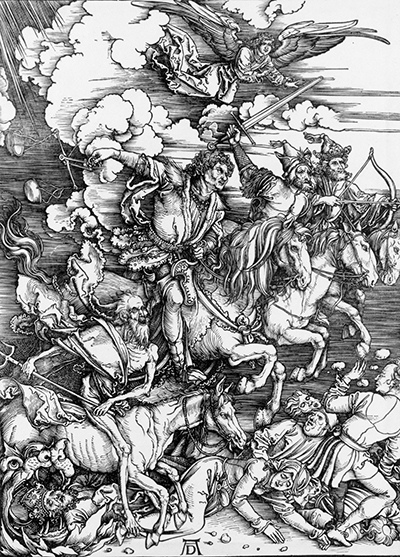The Apocalypse, a series of 15 woodcuts, was created by famous artist Albrecht Dürer. Since the composition was inspired by the Book of Revelations, the woodcuts were filled with dramatic imagery of dragons and demons among other frightening creatures.
Just by looking at them, even illiterate masses understood the story St John was telling in the Book of Revelations—a warning of what would happen when the world came to an end. Perhaps the obsession with end times dictated the subject of the Apocalypse and lead to its success.
With the invention of the print press, a second edition was produced in book form around 1511. Several copies of the book were produced and the message could reach a large number of people. The pictures of the 15 woodcuts appealed to the masses who found the subject matter meaningful as they believed it contained prophecy of end times.
The Four Horsemen of the Apocalypse is the most popular of the Apocalypse series. It contains more powerful imagery of horsemen punishing mankind on dooms day. The crazed men swing their swords to attack the men as their horses trample on those who have fallen on the ground.
There is also a depiction of wide jawed creature swallowing a man. Although an angel is hovering above the scene, he does nothing to help. It is argued that the effect of this Apocalypse is more powerful than the other compositions and that most likely Dürer created the piece himself from start to finish.
Adam and Eve
Although Dürer did not choose a surprising theme for an artist of his time, this painting drew a lot of attention. It is a beautiful nude painting with live size figures of Adam and Eve. Having painted it after travelling to Italy, the piece has Italian influences. The tall figures of Adam and Eve are covering their private areas using branches with leaves. Eve is seen near a tree and holding an apple above a snake. To keep focus on the subjects, it was painted on a dark background, typical in many of his works. 500 years later it is still a masterpiece as it is currently displayed at Museo del Prado in Madrid Spain.
Praying Hands
This artistic piece was also inspired by religion. Dürer created ‘Praying Hands’ as one of pen and ink sketches created for an altar piece. The exquisite drawing is set on a dark blue background and shows only the hands of a praying apostle. The folded sleeves also feature prominently in the painting. The Praying Hands appeal is timeless. These days it is seen in tattoos, t-shirts, soap and bumper stickers.
Albrecht Dürer’s third self portrait
In 1500 A.D. Dürer painted a half portrait of himself in a pose which was only used in portraits depicting Christ. At the time other people, including saints, only appeared in portraits in profile, not from a front view. He also presented himself as a distinguished man with long curly hair, a serious expression and well groomed facial hair. His hand is holding his luxurious brown coat. Because this was a daring thing to do at the time, many people talked about the portrait and wondered what Dürer was trying to communicate.
Knight, Death and the Devil
This is a large print that is part of his three master engravings (Meisterstiche). The other two pieces are Saint Jerome in His study and Melancholia I. Though the trio don’t have similar themes like the Apocalypse pieces did, he used interrelated and complementary technique on them.
Conclusion
Albrecht Dürer was a genius who lived ahead of his time. The self created artist crafted beautiful pieces, some which took several years to complete and others which he never finished because he wanted everything to be perfect and for his artistic creations to tell a story. Everyone is in agreement that he was one of the best artists of the Northern Renaissance. His works are timeless and still relevant in today’s society. They are displayed in museums, reproduced in the internet and on clothing items and studied by students of art who are keen to learn from him.




